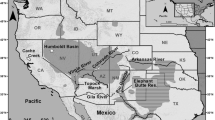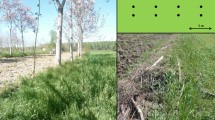Abstract
Termites are ubiquitous detritivores and are a key influence on soil function and nutrient cycles, particularly in arid and semi-arid ecosystems. Locust control presents a unique hazard to termites and the effective functioning of ecosystems as a consequence of the overlap between pesticide applications and termite populations in grassland and desert landscapes. We monitored the effects of locust control methods using ultra-low-volume (ULV) barrier application of a chemical pesticide, fipronil, and a blanket application of a fungal biopesticide, Metarhizium acridum, on wood-eating termites in arid western New South Wales, Australia. We tested the hypothesis that spray applications decrease termite activity at wood baits using a BACI designed field experiment over 2 years. Our replicated control and treatment sites represented the spatial scale of Australian locust control activities. There was no detectable impact of either locust control treatment on termite activity, bait mass loss or termite community composition measures. Non-significant differences in termite survey measures among sites suggested that climate and environmental conditions were stronger drivers of our termite measures than the single, localized and unreplicated application of pesticides more commonly used in locust control operations in arid Australia. A lack of evidence for an impact of our fipronil or Metarhizium application methods supports their use as low hazard locust control options with minimal large scale and longer-term effects on termites in Australian arid rangelands. Future research would be necessary to determine the probable short-term impacts of treatments on individual termite colonies and the possible impacts on non-wood eating termite species in the arid-zone.




Similar content being viewed by others
References
Abe T, Bignell DE, Higashi M (2000) Termites: evolution, sociality, symbioses, ecology. Springer, Berlin
Abensperg-Traun M (1991) Seasonal changes in activity of subterranean termite species (Isoptera) in western Australian wheatbelt habitats. Aust J Ecol 16:331–336
Abensperg-Traun M (1992) The effects of sheep-grazing on the subterranean termite fauna (Isoptera) of the western Australian wheatbelt. Aust J Ecol 17:425–432
Abensperg-Traun M (1993) A comparison of two methods for sampling assemblages of subterranean, wood-eating termites (Isoptera). Aust J Ecol 18:317–324
Abensperg-Traun M, Milewski AV (1995) Abundance and diversity of termites (Isoptera) in unburnt versus burnt vegetation at the barrens in mediterranean western Australia. Aust J Ecol 20:413–417. doi:10.1111/j.1442-9993.1995.tb00557.x
Abensperg-Traun M, Steven D (1997) Latitudinal gradients in the species richness of Australian termites (Isoptera). Aust J Ecol 22:471–476
Abensperg-Traun M, Smith GT, Arnold G, Steven D (1996) The effects of habitat fragmentation and livestock-grazing on animal communities in remnants of gimlet Eucalyptus salubris woodland in the western Australian wheatbelt. I. Arthropods. J Appl Ecol 33(6):1281–1301
Arthurs S, Thomas MB, Langewald J (2003) Field observations of the effects of fenitrothion and Metarhizium anisopliae var. acridum on non-target ground dwelling arthropods in the sahel. Biol Control 26:333–340
Austin AT (2011) Has water limited our imagination for aridland biogeochemistry? Trend Ecol Evol 26:229–235. doi:10.1016/j.tree.2011.02.003
Bignell DE (2006) Termites as soil engineers and soil processors. In: Konig H, Varma A (eds) Intestinal microorganisms of termites and other invertebrates. Springer, Berlin Heidelberg, pp 183–220
Chen Z et al (2015) Lethal and social-mediated effects of ten insecticides on the subterranean termite reticulitermes speratus. J Pest Sci. doi:10.1007/s10340-015-0656-0
Chouvenc T, Su N-Y, Kenneth Grace J (2011) Fifty years of attempted biological control of termites–analysis of a failure. Biol Control 59:69–82
Craig M, Withers P, Bradshaw S (2006) Patterns of diet and microhabitat use by four species of sympatric ctenotus lizards: do they reveal foraging specialisation? J R Soc West Aust 89:1–5
Culliney TW (2013) Role of arthropods in maintaining soil fertility. Agriculture 3:629–659
Davies AB, Eggleton P, Rensburg BJ, Parr CL (2013) Assessing the relative efficiency of termite sampling methods along a rainfall gradient in african savannas. Biotropica 45:474–479
Dawes-Gromadzki TZ (2003) Sampling subterranean termite species diversity and activity in tropical savannas: an assessment of different bait choices. Ecol Entomol 28:397–404. doi:10.1046/j.1365-2311.2003.00525.x
Dawes-Gromadzki TZ (2005) Bugs beneath the surface: the functional significance of soil macroinvertebrates to landscape health in Australia’s tropical savannas. Insect Sci 12:307–312. doi:10.1111/j.1005-295X.2005.00037.x
Evans TA, Gleeson PV (2001) Seasonal and daily activity patterns of subterranean, wood-eating termite foragers. Aust J Zool 49:311–321
Green RH (1979) Sampling design and statistical methods for environmental biologists. Wiley, New York
Greenville A, Dickman C (2005) The ecology of Lerista labialis (Scincidae) in the Simpson desert: reproduction and diet. J Arid Environ 60:611–625
Gunasekara AS, Truong T, Goh KS, Spurlock F, Tjeerdema RS (2007) Environmental fate and toxicology of fipronil. J Pestic Sci 32:189–199
Holt J, Robertson L, Radford B (1993) Effects of tillage and stubble residue treatments on termite activity in two central queensland vertosols. Soil Res 31:311–317. doi:10.1071/SR9930311
Holt J, Bristow K, Mcivor J (1996) The effects of grazing pressure on soil animals and hydraulic properties of two soils in semi-arid tropical queensland. Soil Res 34:69–79. doi:10.1071/SR9960069
Hunter DM (2004) Advances in the control of locusts (Orthoptera: Acrididae) in eastern Australia: from crop protection to preventive control. Aust J Entomol 43:293–303. doi:10.1111/j.1326-6756.2004.00433.x
Huntly N (1991) Herbivores and the dynamics of communities and ecosystems. Annu Rev Ecol Syst 22:477–503
Jouquet P, Traoré S, Choosai C, Hartmann C, Bignell D (2011) Influence of termites on ecosystem functioning. Ecosystem services provided by termites. Eur J Soil Biol 47:215–222
Lee K, Foster R (1991) Soil fauna and soil structure. Soil Res 29:745–775
Mamadou A, Sarr M (2009) Impact of two insecticides used in the control of the desert locust on Psammotermes hybostoma desneux (lsoptera: Rhinotermitidae) in Niger. Afr Entomol 17:147–153
Maute K, French K, Bull CM, Story P, Hose G (2015) Current insecticide treatments used in locust control have less of a short-term impact on Australian arid-zone reptile communities than does temporal variation. Wildl Res 42:50–59
Meteorology ABO (2014) Weather station directory and climate database. Commonwealth of Australia. Accessed 10 Sept 2014
Milchunas DG, Lauenroth WK (1993) Quantitative effects of grazing on vegetation and soils over a global range of environments. Ecol Monogr 63:327–366
Milner RJ (2003) Application of biological control agents in mound building termites (Isoptera: Termitidae): experiences with metarhizium in Australia. Sociobiology 41:419–428
Morton SR et al (2011) A fresh framework for the ecology of arid Australia. J Arid Environ 75:313–329. doi:10.1016/j.jaridenv.2010.11.001
Mugerwa S, Nyangito M, Mpairwe D, Nderitu J (2011) Effect of biotic and abiotic factors on composition and foraging intensity of subterranean termites. Afr J Environ Sci Technol 5:579–588
Noble JC, Müller W, Whitford W, Pfitzner G (2009) The significance of termites as decomposers in contrasting grassland communities of semi-arid eastern Australia. J Arid Environ 73:113–119
Park H, Majer J, Hobbs RJ, Bae T (1993) Harvesting rate of the termite, Drepanotermes tamminensis (hill) within native woodland and shrubland of the western Australian wheatbelt. Ecol Res 8:269–275
Petersen H, Luxton M (1982) A comparative analysis of soil fauna populations and their role in decomposition processes. Oikos 39:288–388
Petra C, Hendrix PF (2007) Role of fauna in soil physical processes. In: Abbot LK, Murphy DV (eds) Soil biological fertility. Springer, Netherlands, pp 61–80
Peveling R (2001) Environmental conservation and locust control-possible conflicts and solutions. J Orthoptera Res 10:171–187
Peveling R et al (2003) Impact of locust control on harvester termites and endemic vertebrate predators in madagascar. J Appl Ecol 40:729–741
Rouland-Lefèvre C (2011) Termites as pests of agriculture. In: Bignell DE, Roisin Y, Lo N (eds) Biology of termites: a modern synthesis. Springer, Netherlands, pp 499–517
Steinbauer M, Peveling R (2011) The impact of the locust control insecticide fipronil on termites and ants in two contrasting habitats in northern Australia. Crop Prot 30:814–825
Story PG, Walker PW, Mcrae H, Hamilton JG (2005) A case study of the Australian plague locust commission and environmental due diligence: why mere legislative compliance is no longer sufficient for environmentally responsible locust control in Australia. Integr Environ Assess Manage 1:245–251
Su N-Y, Scheffrahn RH (1990) Comparison of eleven soil termiticides against the formosan subterranean termite and eastern subterranean termite (Isoptera: Rhinotermitidae). J Econ Entomol 83:1918–1924
Taylor H, Mackay WP, Herrick JE, Guerrero R, Whitford W (1998) Comparison of field methods to detect termite activity in the northern Chihuahuan desert (Isoptera). Sociobiology 32:1–16
Vargo EL, Parman V (2012) Effect of fipronil on subterranean termite colonies (Isoptera: Rhinotermitidae) in the field. J Econ Entomol 105:523–532
Watson JAL, Abbey HM (1993) Atlas of Australian termites. CSIRO Publishing, Clayton
Watson JAL, Perry DH (1981) The Australian harvester temites of the genus drepanotermes (Isoptera: Termitinae). Aust J Zool 29:1–153
Whitford WG, Ludwig JA, Noble JC (1992) The importance of subterranean termites in semi-arid ecosystems in south-eastern Australia. J Arid Environ 22:87–91
Zimmermann G (2007) Review on safety of the entomopathogenic fungus Metarhizium anisopliae. Biocontrol Sci Technol 17:879–920
Acknowledgments
Funding for this project was provided by the Australian Research Council (ARC) and the Australian Plague Locust Commission (APLC) through an ARC Linkage Grant (LP110200105) administered through the University of Wollongong and in collaboration with Flinders University and Macquarie University. Fowlers Gap Arid Zone Research Station, managed by the University of New South Wales, provided access to the site and hosted the project researchers and volunteers. APLC officers, students and volunteers provided field assistance. This study was permitted by the NSW National Parks and Wildlife Service (SL 100629).
Author information
Authors and Affiliations
Corresponding author
Electronic supplementary material
Below is the link to the electronic supplementary material.
Rights and permissions
About this article
Cite this article
Maute, K., French, K., Story, P. et al. Effects of two locust control methods on wood-eating termites in arid Australia. J Insect Conserv 20, 107–118 (2016). https://doi.org/10.1007/s10841-016-9844-3
Received:
Accepted:
Published:
Issue Date:
DOI: https://doi.org/10.1007/s10841-016-9844-3




